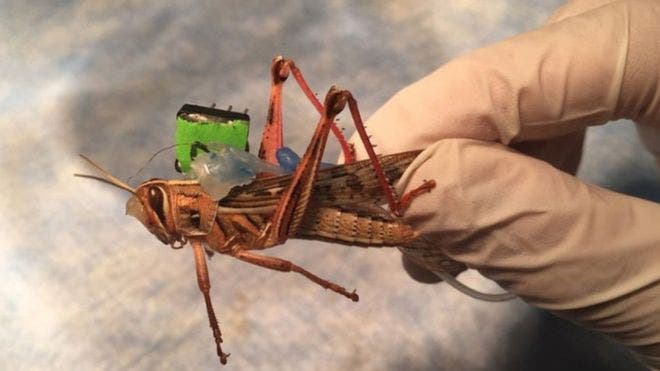
Why build some tech from scratch when nature did all the dirty work for you over millions of years of evolution? That was the thinking behind an innovative project led by Baranidharan Raman, associate professor of biomedical engineering in the School of Engineering and Applied Science Washington University, which aims to use microchip-enabled locusts to sniff out explosives. The project received a $750,000 grant from the US Office of Naval Research and, if found suitable, swarms of locusts could start sniffing for bombs as early as two years from now.
You might not have known this, but locusts have a very keen sense of smell. Each of their antennae is littered with hundreds of thousands of chemical sensors that convert odors into electrical signals, which are then transmitted to the circuits of neurons in the brain.
Previously, Raman and colleagues devised a set of experiments to see whether locusts could be Pavlovian conditioned — namely, to associate one particular stimulus that induces a specific response with a new stimulus. Russian physiologist Ivan Pavlov first demonstrated this form of conditioning in the 1890s in his famous experiments in which dogs were trained to associate the sound of a bell with food. In other words, a neutral stimulus introduced an automated response.
Using various odors, Raman coaxed his lab locusts to automatically respond to the stimuli with an average response time of 500 milliseconds. “The locusts robustly recognized and responded to the trained odor whether it was presented alone or after another odor, but their response time and behavior were less predictable when the trained odor followed a similar odor that evoked highly overlapping neural activity,” said Raman.
Now, a year later, Raman’s team wants to exploit this extraordinary sense of smell to sniff out bombs. Right now, dogs are employed throughout airports or border crossings to detect explosives, drugs or other illicit chemicals, owing to their remarkable sense of smell. But such dogs take years to train and can be in short supply. Locusts, on the other hand, could be just as good as dogs and might be bred by the thousands at a time.
“The canine olfactory system still remains the state-of-the-art sensing system for many engineering applications, including homeland security and medical diagnosis,” Raman said in a statement. “However, the difficulty and the time necessary to train and condition these animals, combined with lack of robust decoding procedures to extract the relevant chemical sending information from the biological systems, pose a significant challenge for wider application.
“We expect this work to develop and demonstrate a proof-of-concept, hybrid locust-based, chemical-sensing approach for explosive detection.”
To control the locusts, the researchers devised an interesting mind-control device. Heat generating “tattoos” would be placed on insect’s wings whose mild heat can be remotely triggered and control. This heat spurs the locusts to fly in a certain direction. Meanwhile, an on board low-power chip placed on the locust’s torso decodes any odor-related electrical signals sent by the antennae’s chemical sensors. This information is then quickly relayed to an authorized person through radio waves. A simple set of LED lights, then flashes: “red” for a bomb, “green” for all clear.
“Even the state-of-the-art miniaturised chemical-sensing devices have a handful of sensors. On the other hand, if you look at the insect antennae, where their chemical sensors are located, there are several hundreds of thousands of sensors and of a variety of types,” Raman told the BBC.
Raman estimates the first prototype might be ready for testing within a year. He also envisions his cyborg locusts sniffing all sorts of chemicals, besides bombs. For instance, these insects could be used in the medical sector to diagnose diseases. Dogs, for instance, have been shown to detect breast and lung cancers with an accuracy between 90 and 95 percent.






